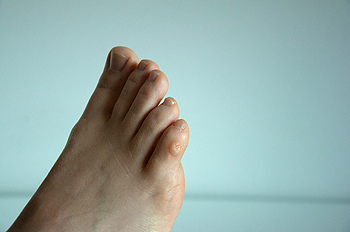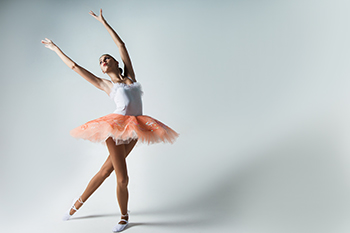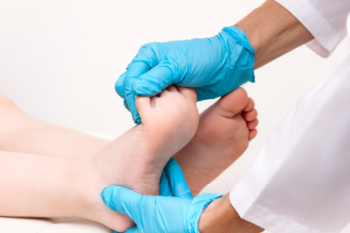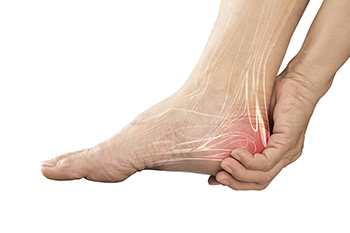Items filtered by date: May 2024
Professional Foot Corn Removal
 Corns are hard, thickened areas of skin that form on the feet in response to pressure and friction. They typically develop on the toes or the soles of the feet. These skin lesions can cause discomfort and pain, particularly when pressure is applied, such as while wearing shoes. Although corns form to protect the skin, they often grow too thick and need to be managed. A podiatrist, or foot doctor, can professionally remove corns through several methods. One common technique is carefully paring down the thickened skin using a scalpel. This should only be done by a professional to avoid injury. For persistent corns, a podiatrist may also use salicylic acid treatments to chemically pare down the excess skin. Additionally, custom orthotics or padding might be recommended to relieve pressure and prevent the recurrence of corns. In severe cases, a podiatrist may suggest surgical correction of the underlying bone structure that causes the friction. If you are struggling with foot corns, it is suggested that you visit a podiatrist for personalized and safe treatment.
Corns are hard, thickened areas of skin that form on the feet in response to pressure and friction. They typically develop on the toes or the soles of the feet. These skin lesions can cause discomfort and pain, particularly when pressure is applied, such as while wearing shoes. Although corns form to protect the skin, they often grow too thick and need to be managed. A podiatrist, or foot doctor, can professionally remove corns through several methods. One common technique is carefully paring down the thickened skin using a scalpel. This should only be done by a professional to avoid injury. For persistent corns, a podiatrist may also use salicylic acid treatments to chemically pare down the excess skin. Additionally, custom orthotics or padding might be recommended to relieve pressure and prevent the recurrence of corns. In severe cases, a podiatrist may suggest surgical correction of the underlying bone structure that causes the friction. If you are struggling with foot corns, it is suggested that you visit a podiatrist for personalized and safe treatment.
If you have any concerns regarding your feet and ankles, contact Donovan Gowdie, DPM of The Foot & Ankle Treatment Center. Our doctor will treat your foot and ankle needs.
Corns: What Are They? and How Do You Get Rid of Them?
Corns can be described as areas of the skin that have thickened to the point of becoming painful or irritating. They are often layers and layers of the skin that have become dry and rough, and are normally smaller than calluses.
Ways to Prevent Corns
There are many ways to get rid of painful corns such as wearing:
- Well-fitting socks
- Comfortable shoes that are not tight around your foot
- Shoes that offer support
Treating Corns
Treatment of corns involves removing the dead skin that has built up in the specific area of the foot. Consult with Our doctor to determine the best treatment option for your case of corns.
If you have any questions please feel free to contact our office located in Watkinsville, GA . We offer the newest diagnostic and treatment technologies for all your foot and ankle needs.
Foot and Ankle Injuries Common Among Dancers

Foot and ankle injuries are common among dancers, posing significant challenges to their performance and well-being. Achilles tendonitis is the result of repetitive strain on the Achilles tendon and can lead to inflammation and tightness, affecting movement and stability. Ankle sprains, resulting from overstretching or tearing of ligaments, are among the most common dance injuries, causing pain, swelling, and reduced mobility. Stress fractures are hairline cracks in bones of the feet brought about by repetitive impact or overuse. By incorporating proper warm-up and cool-down routines, maintaining correct technique, and integrating strength and flexibility exercises into training, a dancer can help reduce the likelihood of injury. Additionally, wearing supportive footwear and listening to the body's signals can further safeguard against potential harm. When faced with such dance injuries, seeking assistance from a podiatrist is essential. These foot doctors can diagnose the root cause of the injury and recommend the appropriate treatment plan to aid in recovery. If you are a dancer, it is suggested that you include a podiatrist as part of your medical team.
Sports related foot and ankle injuries require proper treatment before players can go back to their regular routines. For more information, contact Donovan Gowdie, DPM of The Foot & Ankle Treatment Center. Our doctor can provide the care you need to keep you pain-free and on your feet.
Sports Related Foot and Ankle Injuries
Foot and ankle injuries are a common occurrence when it comes to athletes of any sport. While many athletes dismiss the initial aches and pains, the truth is that ignoring potential foot and ankle injuries can lead to serious problems. As athletes continue to place pressure and strain the area further, a mild injury can turn into something as serious as a rupture and may lead to a permanent disability. There are many factors that contribute to sports related foot and ankle injuries, which include failure to warm up properly, not providing support or wearing bad footwear. Common injuries and conditions athletes face, including:
- Plantar Fasciitis
- Plantar Fasciosis
- Achilles Tendinitis
- Achilles Tendon Rupture
- Ankle Sprains
Sports related injuries are commonly treated using the RICE method. This includes rest, applying ice to the injured area, compression and elevating the ankle. More serious sprains and injuries may require surgery, which could include arthroscopic and reconstructive surgery. Rehabilitation and therapy may also be required in order to get any recovering athlete to become fully functional again. Any unusual aches and pains an athlete sustains must be evaluated by a licensed, reputable medical professional.
If you have any questions please feel free to contact our office located in Watkinsville, GA . We offer the newest diagnostic and treatment technologies for all your foot and ankle needs.
Childhood Rheumatoid Arthritis

Juvenile rheumatoid arthritis, or JRA, a chronic autoimmune disorder, occurs when the body's immune system mistakenly attacks its own tissues, leading to joint inflammation and damage. While the exact cause remains elusive, genetic predisposition and environmental factors likely play significant roles. Children with a family history of autoimmune diseases are at higher risk, although JRA can affect anyone. Symptoms may include joint stiffness, swelling, and pain, particularly in the feet and ankles. In some cases, JRA can lead to complications like joint deformities and growth problems. Diagnosing this condition involves a thorough evaluation of symptoms, medical history, and physical exams, often supplemented with blood tests and imaging studies. If your child has foot or ankle joint pain, it is strongly suggested that you schedule an appointment with a podiatrist who can collaborate with other relevant healthcare professionals to tailor a treatment plan that can relieve pain, maintain joint function, and prevent deformities.
Making sure that your children maintain good foot health is very important as they grow. If you have any questions, contact Donovan Gowdie, DPM of The Foot & Ankle Treatment Center. Our doctor can provide the care you need to keep you pain-free and on your feet.
Keeping Children's Feet Healthy
Having healthy feet during childhood can help prevent medical problems later in life, namely in the back and legs. As children grow, their feet require different types of care. Here are some things to consider...
Although babies do not walk yet, it is still very important to take care of their feet.
Avoid putting tight shoes or socks on his or her feet.
Allow the baby to stretch and kick his or her feet to feel comfortable.
As a toddler, kids are now on the move and begin to develop differently. At this age, toddlers are getting a feel for walking, so don’t be alarmed if your toddler is unsteady or ‘walks funny’.
As your child gets older, it is important to teach them how to take care of their feet.
Show them proper hygiene to prevent infections such as fungus.
Be watchful for any pain or injury.
Have all injuries checked by a doctor as soon as possible.
Comfortable, protective shoes should always be worn, especially at play.
If you have any questions please feel free to contact our office located in Watkinsville, GA . We offer the newest diagnostic and treatment technologies for all your foot and ankle needs.
Causes and Common Triggers of Heel Pain

Heel pain can stem from various factors, affecting individuals of all ages and activity levels. Primarily localized to the underside or back of the heel, this discomfort can significantly impact mobility and quality of life. The causes of heel pain are multifaceted, with common culprits including plantar fasciitis, Achilles tendonitis, heel spurs, and stress fractures. Plantar fasciitis, caused by inflammation of the thick band of tissue that connects the heel to the toes, often arises from overuse, improper footwear, or biomechanical issues. Achilles tendonitis, involving inflammation of the Achilles tendon, commonly results from overuse or sudden increases in activity level. Heel spurs, bony growths on the underside of the heel bone, can develop due to repetitive stress or poor foot mechanics. Stress fractures, small cracks in the heel bone, may occur from overtraining or sudden changes in activity. If you have heel pain, it is strongly suggested that you consult a podiatrist who can determine the cause and offer you appropriate relief and treatment solutions.
Many people suffer from bouts of heel pain. For more information, contact Donovan Gowdie, DPM of The Foot & Ankle Treatment Center. Our doctor can provide the care you need to keep you pain-free and on your feet.
Causes of Heel Pain
Heel pain is often associated with plantar fasciitis. The plantar fascia is a band of tissues that extends along the bottom of the foot. A rip or tear in this ligament can cause inflammation of the tissue.
Achilles tendonitis is another cause of heel pain. Inflammation of the Achilles tendon will cause pain from fractures and muscle tearing. Lack of flexibility is also another symptom.
Heel spurs are another cause of pain. When the tissues of the plantar fascia undergo a great deal of stress, it can lead to ligament separation from the heel bone, causing heel spurs.
Why Might Heel Pain Occur?
- Wearing ill-fitting shoes
- Wearing non-supportive shoes
- Weight change
- Excessive running
Treatments
Heel pain should be treated as soon as possible for immediate results. Keeping your feet in a stress-free environment will help. If you suffer from Achilles tendonitis or plantar fasciitis, applying ice will reduce the swelling. Stretching before an exercise like running will help the muscles. Using all these tips will help make heel pain a condition of the past.
If you have any questions please contact our office located in Watkinsville, GA . We offer the newest diagnostic and treatment technologies for all your foot and ankle needs.
